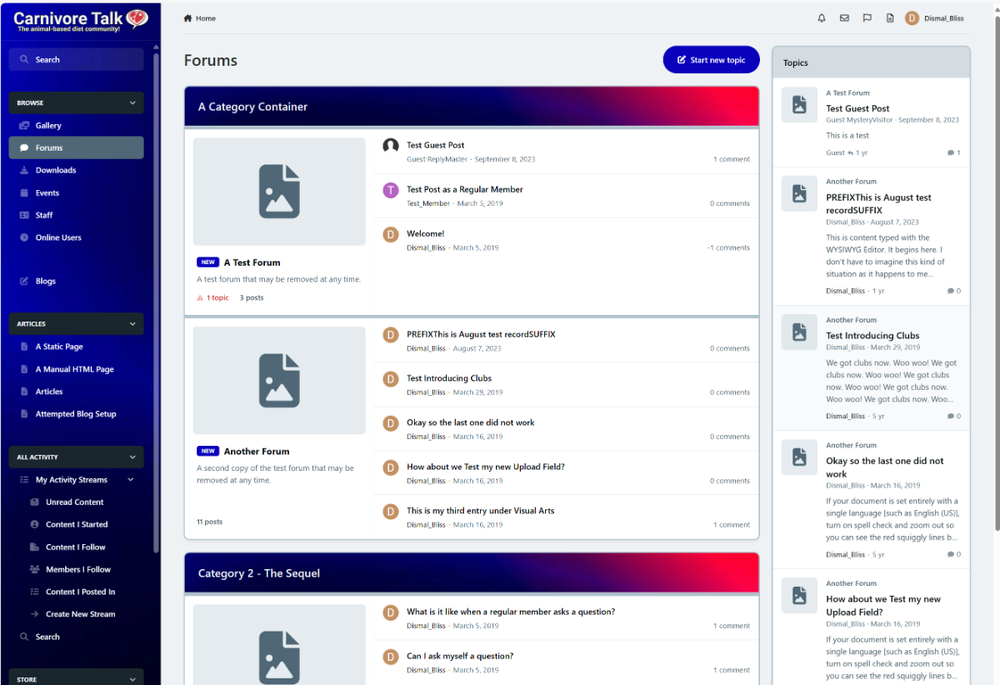Everything posted by Bob
-
How do you like your steak?
Poll option for "Raw / Uncooked" has been added 😉
- What Did You Eat Today?
- Eggs
- Cast Iron Pan VS Stainless Steel Pan
-
Longevity Doctor Peter Attia Says the Red Meat-Cancer Connection Is Bad Science
I'm not sure if you are being serious or facetious here, lol. I have a few friends that still mask up in crowded or indoor settings. One of them personally has major respiratory issues, and another has a handicapped child with an extremely low immune system and doesn't want to bring anything home to them. Masks and social distancing do indeed reduce your risk of infection. But I think covid-19 has devolved and become just a common cold now, taking it's place next to the other 4 coronaviruses that circulate and infect mankind. The initial strain and earlier generations of the virus that did indeed pack a wallop are long gone. I lost several friends, both young and old, during the pandemic.
-
Longevity Doctor Peter Attia Says the Red Meat-Cancer Connection Is Bad Science
Longevity Doctor Peter Attia Says the Red Meat-Cancer Connection Is Bad Science Story by Kelsey Kryger, C.P.T. Red meat might not deserve its long-standing reputation as a dietary villain, as Peter Attia, M.D., shared on the Triggernometry podcast recently. Attia is a physician specializing in longevity and optimal health, with a background in surgical oncology and nutritional science. As the founder of Early Medical, he focuses on using research to improve lifespan and health. Several studies have suggested red meat consumption be linked to colon cancer, diabetes, and other cardiovascular diseases. But, Attia calls this an enduring example of bad science that never dies—especially because epidemiology only identifies associations rather than causations. "People consuming red meat and people not consuming red meat tend to be proxies, on average, for very different behaviors," Attia says. He explains that people consuming red meat typically eat more processed foods, while people who avoid red meat usually engage in healthier habits, like eating fruits and vegetables or exercising regularly. "When you strip all of those things away and you normalize, for say, vegetable consumption, that cancer-causing effect of red meat completely vanishes," he says. Plus, not all red meat is created equally. Consuming a highly-processed beef jerky sticks or bacon is far different than eating grass-fed beef, he says. Ultimately, the red meat debate is more nuanced than it’s often portrayed. Attia emphasizes that broad generalizations fail to account for critical lifestyle factors, which significantly influence health outcomes. "When you just compare people who eat red meat versus people who don't, you're going to get that difference in risk," Attia says. "But, when you start to correct for everything—including for servings of vegetables in a day—all of a sudden, the supposed harm of red meat goes away." ARTICLE SOURCE: https://www.msn.com/en-us/health/other/longevity-doctor-peter-attia-says-the-red-meat-cancer-connection-is-bad-science/ar-AA1xXlO2?
- "MARCH with Motivation" - March Fitness Challenge & Daily Weigh-in!
- I'm being interviewed by MeatingWellness LIVE this evening - Come join us!
-
LIVE! CarnivoreTalk and MeatingWellness
until
Come join us tonight as Cristie from MeatingWellmess and Bob from CarnivoreTalk discuss the benefits of a Carnivore Diet. - I am convinced that I can heal myself through carnivore diet
- "MARCH with Motivation" - March Fitness Challenge & Daily Weigh-in!
- "MARCH with Motivation" - March Fitness Challenge & Daily Weigh-in!
-
New design when we upgrade to the new Invision 5...
We have an "Unread Content" button at the top of the page... https://carnivoretalk.com/discover/unread/
-
Why is bacon so delicious
A search seems to indicate that it is pretty safe. It's a salt that accelerates curing, prevents/slows oxidation, and the body converts it to vitamin C. Unless you as an individual have a sensitivity towards it, it's probably fine for most people,,, https://thefooduntold.com/food-additives/what-is-sodium-erythorbate-e316-in-food/
- Eggs
-
Why is bacon so delicious
Oh I know. I said the Creator had prohibited it under the Law of Moses (the old covenant). There are no dietary prohibitions in the new covenant (except for abstaining from blood)... “[He] erased the handwritten document that consisted of decrees and was in opposition to us. He has taken it out of the way.” - Colossians 2:14 “By means of his flesh he abolished the enmity, the Law of commandments consisting in decrees.” - Ephesians 2:15
-
Lingering COVID issues.... Taste and Smell
Sounds like it hits at random. When it does, is it all food that tastes off, or will it just be the beef and everything else is fine, or the eggs like a couple weeks ago but then everything else is fine?
-
New design when we upgrade to the new Invision 5...
I've been playing around with the new software over on my demo site. In Invision 5, I'm trying to duplicate our color scheme and branding. Here is a sneak peek of what I think it is going to look like on the main index page.
-
High Triglycerides on a Carnivore or Keto Diet! [Video/Podcast]
What was the value? Did you get a lipid panel prior to carnivore 4+ months ago for comparison? Were you fasted for 12-14 hours, no more, no less, when the blood was drawn? You've lost 40 lbs (18kg) in the last 4 months, so congratulations! Like I explained in the video, think of your stored fat as triglyceride in solid form. As you lose the weight on your body, the fat dissolves and enters your blood stream. Triglycerides are broken down and used for energy. For most people, they see their trigs drop like a rock, because they are being used for energy. For others, like myself, they build up in the blood. What we have to do is figure out why. In your case, I imagine it has to do with your diabetes. High triglycerides is common in people with insulin resistance and metabolic syndrome. As you A1C comes down, hopefully your trigs will too. But I don't recommend putting too much stock in a lipid panel while you are actively losing weight. It can be all over the place. I would wait 3-6 months after your weight loss has stopped and remained stable to get a lipid panel that would be more accurate. More blood tests would rule out issues with the liver or low thyroid, etc.
- Mother on carnivore diet says her children are ‘flourishing’ eating only meat and eggs
-
Mother on carnivore diet says her children are ‘flourishing’ eating only meat and eggs
Mother on carnivore diet says her children are ‘flourishing’ eating only meat and eggs Story by Molly Powell A mother who only eats a diet of meat, fish, eggs and full-fat dairy has encouraged her husband and two children to follow suit. In a bid to loose weight, Olivia Khwaja, 50, a freelance strategic consultant from Ascot, initially followed the keto diet - which is high-fat, low-carb. She dropped from 95kg (14st 3lbs) to 75kg (11st 11lbs) from 2020 to 2022. That year, she discovered the carnivore diet, which required her to cut out plant-based foods entirely. This means she solely eats animal products such as steak, eggs and chicken liver pate. She has since lost an additional 20kg, dropping to 55kg (8st 9lbs). NHS advice says consuming too much meat can increase the likelihood of people getting bowel cancer and recommends a balanced diet including fruits and vegetables – but Khwaja said her new diet has given her smoother skin and a clearer mind on top of the benefits to her waistline. Olivia Khwaja (PA) Such was her success that she has now inspired her husband Greg, 50, and their children, Eden, 16, and Bailey, 13, to follow suit, with Greg losing 39kg and their children “flourishing”. Khwaja has shared her journey with 10,000 Instagram followers, under the handle @oliviakhwaja, focusing on advice to cut out processed foods and said she has “not heard much” criticism on social media or from her children’s school. Khwaja told PA Real Life: “After being on the carnivore diet for a few weeks, I woke up and I just felt this feeling of euphoria, like I’ve never felt so happy and so excited about life. And just looking at the sky, I was like, ‘It’s just so blue and so beautiful’. It’s like I was living under a cloud without realising and it just lifted. I’ve never pushed either of my children into this. They’re on their own journey, but I think they’re both happier avoiding addictive foods and love the freedom that comes with it.” Olivia has inspired her husband Greg and two children Eden, 16, and Bailey, 13, to also follow the diet (PA) Khwaja wanted to make lifestyle changes to improve her health after losing her parents in 2014 and 2015. “My mum had type 2 diabetes … it made me think that I should improve my health so I don’t get the conditions when I’m older,” she said. “My dad had Alzheimer’s, which encouraged me too.” So, with the additional goal of losing weight, Khwaja followed the keto diet from 2020 to 2022, consuming high-fat and low-carb foods. The British Heart Foundation does not recommend the diet for losing weight due to limited research into the keto diet for weight loss, but Olivia said she lost 20kg, with her BMI dropping from 38.3 to a 30.3, and felt more energised. In 2022, she came across the carnivore diet on social media, where it was receiving “rave reviews” from followers. Initially, she was “against it” due to its exclusion of fruit and vegetables, but decided to “keep an open mind” and give it a try. Olivia Khwaja On a typical day, Khwaja now eats her first meal of locally-sourced eggs and sardines at around 4pm, but this can change depending on when she is hungry. A few hours later, she has a large ribeye steak cooked in beef tallow, often accompanied by homemade mayonnaise. On weekends, she and her family also have homemade jerky, bacon, sausages and homemade chicken liver pate on its own, without bread. “I just buy eggs, proper butter, and meat whenever we want it and keep it in the fridge,” she said. “Whenever I get hungry, I go into the fridge and cook something. We eat everything simply … it’s a simple life.” After just three weeks on the diet, Khwaja felt like a “new woman” and now weighs around 55kg, with a normal BMI of 22.2. Khwaja said she can also cycle faster with a quicker recovery time, has a clearer mind, softer skin and no longer has skin tags. “I’ve never felt so good in my life – I can’t remember feeling this positive and healthy, and having so much energy, as a child or a teenager, it’s transformed my life,” she said. Since following the carnivore diet, her husband and children have got on board, and Khwaja claims they have experienced similar benefits. She said her husband has gone from 122kg (19st 3lb) to 83kg (13st 1lb) and also feels more energised. She said: “I thought, we spend so much money buying vegetables and time cutting them, chopping them, steaming them, putting them on a plate, and then most of the time we put them back in the fridge, because my children don’t finish them and they don’t like them, I’m just not going to bother anymore. And we stopped doing that, and that saved a ton of money. They saw mine and my husband’s steak, so wanted to try going carnivore too. But my son does still eat fruit sometimes.” Olivia Khwaja before she lost the weight (PA) Since switching diets, Khwaja said she feels her children are “flourishing”. She claimed their skin has cleared and her daughter is excelling in sports and athletics. Occasionally, her children have “fallen off the wagon” and eaten chocolate, but Khwaja said they quickly notice how “bad they feel” afterwards. To people who would argue Khwaja is damaging her children’s health by not giving them fruit and vegetables, she said: “It would be worthwhile they do some research, because all the nutrients they need are available in abundance in meat and much more so than in vegetables.” She shares her health journey on Instagram under the handle @oliviakhwaja, and Khwaja claims she has not received criticism by her 10,000 followers or her children’s school. “I coach families who want to help their kids transition away from processed foods, but I never tell anyone to stop their children from eating vegetables,” she said. “That’s just a personal choice for our family. I’m sure plenty of people disagree, but I haven’t heard much from them.” To people who are sceptical about the carnivore diet, and have concerns it may cause cancer, she said: “I totally understand their concerns – I was at least sceptical. But my main learning from this whole journey has been that what we think we know about any diet isn’t in any way concluded. In my case, it worked for me and I saw the benefits quickly.” The NHS recommends you speak to your GP about losing weight safely by eating a healthy, balanced diet and regular physical activity. ARTICLE SOURCE: https://www.msn.com/en-us/health/other/mother-on-carnivore-diet-says-her-children-are-flourishing-eating-only-meat-and-eggs/ar-AA1AcMEG?
-
Carnivore worked for me!
What works for one isn’t going to work for another necessarily. Now I was fortunate that nearly everything that was talked about in carnivore and how to do it worked for me. You know, 70 percent fat, 30 percent protein- Boom! I lost weight. Had no problem. If I stalled out I just kept eating what I did. I didn’t do no tricks, and everything would kick back in a few weeks to a month or so. JOIN THIS CHANNEL TO GET ACCESS TO PERKS! https://www.youtube.com/channel/UCeAwaxsqfNEK4ZtfWX3Dz3g/join VISIT OUR FREE KETO/CARNIVORE COMMUNITY! https://www.CarnivoreTalk.com LET'S DO A VIDEO TOGETHER! Have YOU had success with a meat-based keto, ketovore, carnivore, carnivore-centric, or animal-based diet? Let's do a video together! Contact me using this form... https://carnivoretalk.com/contact/ HAVE YOUR QUESTION ANSWERED IN A FUTURE VIDEO: Click the link below to leave us a Voicemail, and we might feature your question on the next episode of Carnivore Talk. https://carnivoretalk.com/voicemail/ SEND SNAIL MAIL TO: Robert Angle Carnivore Talk PO Box 1367 Stow, OH 44224 DISCLAIMER: The Carnivore Talk website and its audio and video content is for general informational purposes only. The use of the information found within our content or from materials linked to from our content is at the user’s own risk. The content published by Carnivore Talk is not intended to be a substitute for professional medical advice, diagnosis, or treatment. Users should seek the assistance of their health care professionals to obtain medical advice and to diagnose or treat any condition.
-
PHOSPHORUS?
I remember when mine hit 4.8 and I remarked to my nephrologist about it being above the high range, and he said he wasn't worried about it. He said the risk for osteoporosis doesn't start until at least 5.5 and up. After 6 months on my carnivore diet mine was up to 5.3 but he still wasn't concerned and was happier about some of the other small improvements I was experiencing. Then, after the fenofibrate debacle that I talked about in the video you watched (which was prescribed by my PCP, and my nephro said get off that stuff immediately), my phosphorous was up to 9.2. I stopped drinking dark colored sodas (which contain Phosphoric acid) and went a month without cheese and brought it down to 8.3. I'll be testing again this week. So far, nobody has mentioned taking a phosphate binder, but the thought has been bouncing around in the back of my mind. The problem is that meat is heavy on the phosphorous. But DAIRY contains the most concentrated phosphorous of them all. The only way to lower it is to excrete it through the urine. The tricky juggling act is to try not to consume it faster than the kidney can expel it. Start with cutting out dark sodas if you are still drinking them. In fact, read the labels of any food or beverage and make sure none of the ingredients have the letters PHOS in them. If you can bear it, try to cut down on or eliminate cheeses and dairy. I don't think this applies to butter and ghee. This page and the food chart at the bottom is pretty helpful... https://www.kidney.org/kidney-topics/phosphorus-and-your-diet
-
Why is bacon so delicious
This is an interesting topic: Why did the Creator ban the consumption of pork under the law of Moses? Some say it was just one of the many ways to set the Israelites apart as different from the pagan nations around them. Others say that it was the divine wisdom of the Almighy, knowing that undercooked pork carried the risk of many food-borne illnesses, and so this was a protection. And yet others see it as symbolism - the pig represented hypocrisy, because it put forth it's split hoof as if to say "see I am kosher" on the outside, but by not chewing the cud it was not clean on the inside. INTERESTINGLY, the animals that split it's hoof and chewed it cud were ruminants. Ruminants were more nutritious because of their 4-chambered stomachs. They could remove all the impurities, and at the same time extract all the nutrition, from the grasses they ate. Ruminant meat was thus considered superior, even in ancient Israelite culture.
-
anyone a fan of Xylitol gum?
I chew sugar free gum, which contains xylitol I believe, a few times a week. It doesn't bother me unless I go through stick after stick. Then it adds up and gives me gas.





